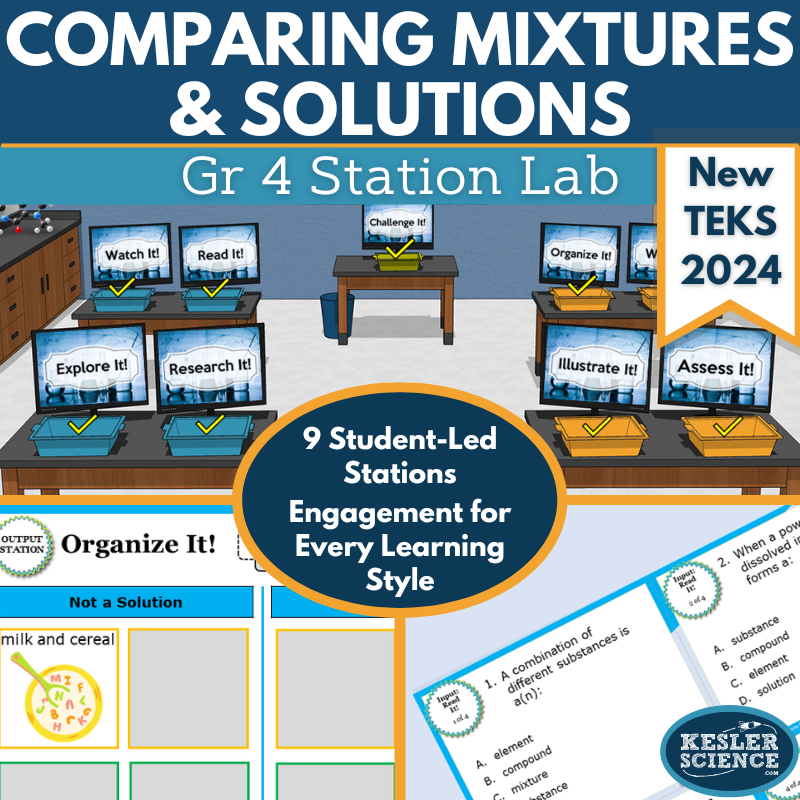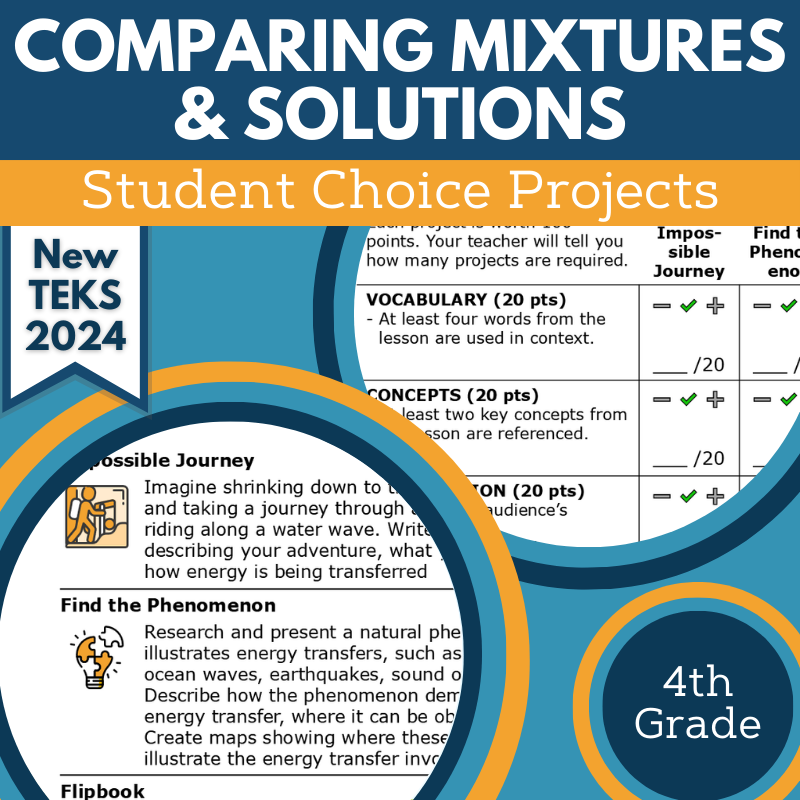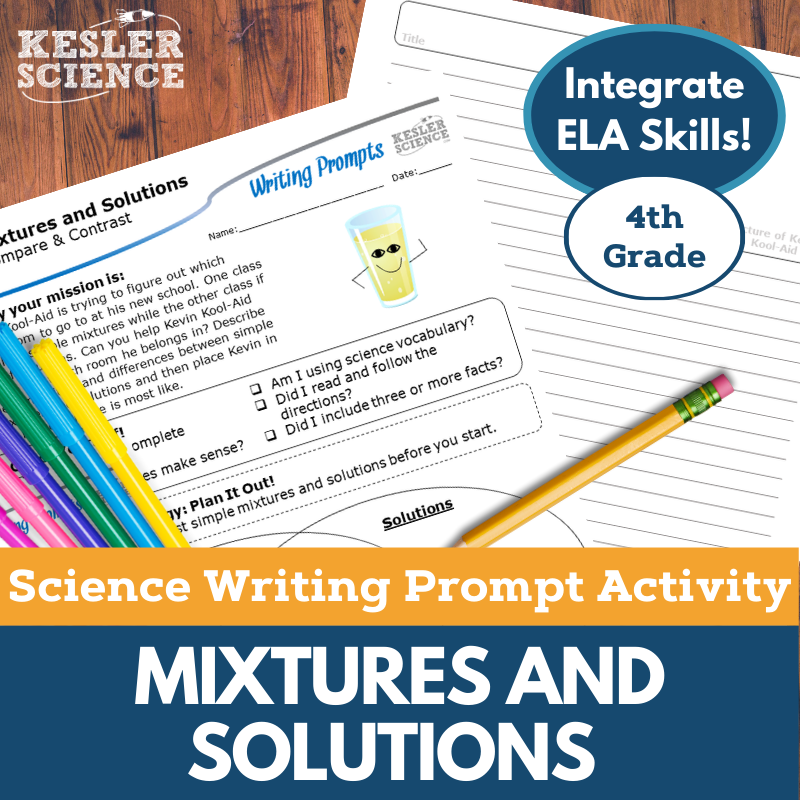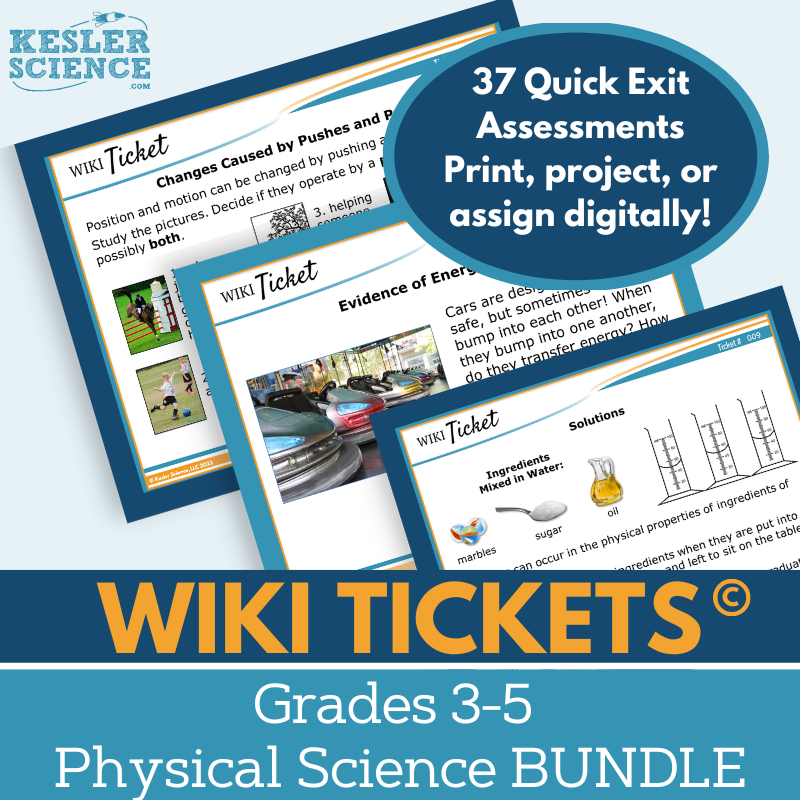Comparing Mixtures & Solutions Activities for 4th Grade Science
This 5E lesson for 4th grade helps students explore and compare different types of mixtures and solutions, including liquids in liquids and solids in liquids, aligned with TEKS 4.6B. The resources below will give students a comprehensive understanding of mixtures and solutions. All of the following materials are also included in the Kesler Science Membership.
The Kesler Science Comparing Mixtures & Solutions 5E Lesson for 4th grade is designed to help students investigate and compare different types of mixtures, including solutions made from liquids in liquids and solids in liquids. This unit includes editable PowerPoints, worksheets, choice projects, and assessments, offering flexible, student-led learning. It’s aligned with the 2021 TEKS standard 4.6B and can be used both in-person and virtually.
Students explore key questions like how to compare the physical properties of mixtures and solutions, and how to identify an unknown mixture. The lesson is divided into five phases: engagement, exploration, explanation, elaboration, and evaluation. During exploration, students engage in a differentiated, hands-on station lab with nine stations, each catering to different learning styles and offering multiple ways to absorb and demonstrate understanding.
The lesson includes editable presentations, interactive notebooks in both English and Spanish, and projects that extend learning beyond the classroom. Assessments are aligned with STAAR 2.0 and available in modified versions, making this a comprehensive and flexible unit for diverse learners.
The Kesler Science Comparing Mixtures & Solutions 5E Lesson for 4th grade is designed to help students investigate and compare different types of mixtures, including solutions made from liquids in liquids and solids in liquids. This unit includes editable PowerPoints, worksheets, choice projects, and assessments, offering flexible, student-led learning. It’s aligned with the 2021 TEKS standard 4.6B and can be used both in-person and virtually.
Students explore key questions like how to compare the physical properties of mixtures and solutions, and how to identify an unknown mixture. The lesson is divided into five phases: engagement, exploration, explanation, elaboration, and evaluation. During exploration, students engage in a differentiated, hands-on station lab with nine stations, each catering to different learning styles and offering multiple ways to absorb and demonstrate understanding.
The lesson includes editable presentations, interactive notebooks in both English and Spanish, and projects that extend learning beyond the classroom. Assessments are aligned with STAAR 2.0 and available in modified versions, making this a comprehensive and flexible unit for diverse learners.
This student-led station lab for TEKS 4.6B engages 4th-grade students in comparing the physical properties of solutions and mixtures. It includes nine differentiated, modular stations, allowing students to direct their learning while teachers facilitate. The stations cover both the science of mixtures and solutions, encouraging hands-on exploration and critical thinking.
Students will use various resources like videos, readings, and tasks to explore key concepts. They’ll compare physical properties, determine whether mixtures are solutions, and apply their knowledge to real-world scenarios. The stations offer input activities like watching videos, reading passages (available in English and Spanish), and researching mixtures, as well as output activities such as organizing, illustrating, and writing about their findings. A challenge station extends learning with bonus activities for early finishers and advanced students.
This resource is designed for both in-person and virtual learning environments, making it flexible for any classroom setup.
This student-led station lab for TEKS 4.6B engages 4th-grade students in comparing the physical properties of solutions and mixtures. It includes nine differentiated, modular stations, allowing students to direct their learning while teachers facilitate. The stations cover both the science of mixtures and solutions, encouraging hands-on exploration and critical thinking.
Students will use various resources like videos, readings, and tasks to explore key concepts. They’ll compare physical properties, determine whether mixtures are solutions, and apply their knowledge to real-world scenarios. The stations offer input activities like watching videos, reading passages (available in English and Spanish), and researching mixtures, as well as output activities such as organizing, illustrating, and writing about their findings. A challenge station extends learning with bonus activities for early finishers and advanced students.
This resource is designed for both in-person and virtual learning environments, making it flexible for any classroom setup.
The Comparing Mixtures and Solutions Student Choice Projects align with the 2021 TEKS standard 4.6B, offering 4th-grade students six different project options plus a "design your own" choice. A grading rubric allows for teacher, peer, or self-assessment. This resource is also part of the Comparing Mixtures & Solutions Complete Lesson for TEKS 4.6B.
These flexible projects cater to various student needs, with modified options for remediation and challenges for advanced learners. Teachers can adjust the rubric as needed. The projects offer multimodal choices, enabling students to creatively demonstrate their understanding using standard classroom supplies like paper, markers, and scissors, with many options for digital completion.
The Comparing Mixtures and Solutions Student Choice Projects align with the 2021 TEKS standard 4.6B, offering 4th-grade students six different project options plus a "design your own" choice. A grading rubric allows for teacher, peer, or self-assessment. This resource is also part of the Comparing Mixtures & Solutions Complete Lesson for TEKS 4.6B.
These flexible projects cater to various student needs, with modified options for remediation and challenges for advanced learners. Teachers can adjust the rubric as needed. The projects offer multimodal choices, enabling students to creatively demonstrate their understanding using standard classroom supplies like paper, markers, and scissors, with many options for digital completion.
The Mixtures and Solutions Science and ELA Integrated Writing Activity for 4th grade engages students in comparing and contrasting mixtures, promoting both science reasoning and writing skills. This TEKS aligned activity is designed for virtual learning, ensuring that students remain engaged outside the classroom.
This resource includes teacher directions with an answer guide, project ideas, and rubrics. It also offers a projection version for virtual classes and full-sized handouts with prompts, self-checks, and pre-writing strategies. Additionally, there are half-sheet handouts for interactive notebooks and a digital interactive version in PowerPoint, which can be converted to Google Slides for in-person or remote learners.
The activity can be used for various purposes, including cross-curricular lessons, formative assessments, student choice projects, or enrichment for early finishers. It also works well for extra credit, make-up work, TELPAS samples, and differentiation. Ideal for bulletin boards or student anthologies, this writing prompt enhances science literacy while reinforcing ELA skills.
The Mixtures and Solutions Science and ELA Integrated Writing Activity for 4th grade engages students in comparing and contrasting mixtures, promoting both science reasoning and writing skills. This TEKS aligned activity is designed for virtual learning, ensuring that students remain engaged outside the classroom.
This resource includes teacher directions with an answer guide, project ideas, and rubrics. It also offers a projection version for virtual classes and full-sized handouts with prompts, self-checks, and pre-writing strategies. Additionally, there are half-sheet handouts for interactive notebooks and a digital interactive version in PowerPoint, which can be converted to Google Slides for in-person or remote learners.
The activity can be used for various purposes, including cross-curricular lessons, formative assessments, student choice projects, or enrichment for early finishers. It also works well for extra credit, make-up work, TELPAS samples, and differentiation. Ideal for bulletin boards or student anthologies, this writing prompt enhances science literacy while reinforcing ELA skills.
The WIKI Tickets© Physical Science Set offers 37 formative assessments for 3rd–5th grade science, designed to check student understanding in an engaging and colorful way. Each topic comes with five formats: a full-screen display for projection, three handout versions (full, split, and quarter-page sizes), and a digital interactive version compatible with PowerPoint and Google Slides.
Aligned with NGSS and TEKS standards for upper elementary science, this set covers various topics, including changes caused by pushes and pulls, energy transfer, forms of energy, properties of matter, and force interactions. Some topics feature multiple assessments, and each set includes a bonus table of contents for easy alignment reference.
These assessments are suitable for both in-person and virtual learning, allowing students to engage with the material on campus or remotely. WIKI Tickets© can be used as exit tickets, bellringers, or to check understanding at any time. Whether projected on a screen, printed as handouts, or assigned digitally, they provide versatile tools for gauging student progress.
The WIKI Tickets© Physical Science Set offers 37 formative assessments for 3rd–5th grade science, designed to check student understanding in an engaging and colorful way. Each topic comes with five formats: a full-screen display for projection, three handout versions (full, split, and quarter-page sizes), and a digital interactive version compatible with PowerPoint and Google Slides.
Aligned with NGSS and TEKS standards for upper elementary science, this set covers various topics, including changes caused by pushes and pulls, energy transfer, forms of energy, properties of matter, and force interactions. Some topics feature multiple assessments, and each set includes a bonus table of contents for easy alignment reference.
These assessments are suitable for both in-person and virtual learning, allowing students to engage with the material on campus or remotely. WIKI Tickets© can be used as exit tickets, bellringers, or to check understanding at any time. Whether projected on a screen, printed as handouts, or assigned digitally, they provide versatile tools for gauging student progress.
Year-Round Resources
These year-round activities will increase your students' understanding of many middle school science topics. All of these activities are also included in the Kesler Science Membership.
Visual Data & Graphing
You're not alone if your students struggle with understanding graphs, charts, and tables. It's a skill that takes an enormous amount of practice. This resource will help students build a strong foundation in analyzing data and creating their own data visualizations.
Bell Ringers and Warm-Ups
These middle school science bell ringers are an excellent way to engage your students as soon as they walk into your classroom. This comprehensive FULL YEAR resource includes everything you need to start off each science class with an interesting warm-up activity.
Review Board Games
Each game board has been carefully designed to keep students engaged. There are 10 different action spaces on each board and dozens of question cards. All of the actions are related to science concepts and keep the students motivated throughout the game.
Each game is ready to play. Simply print out the board and the cards and let the students enjoy reviewing nine different units.
Essential Questions and Standards
Below are the essential questions and standards associated with the lessons and activities included in the atoms unit. This topic is only one of more than 100 middle school science topics included in the Kesler Science Membership.
-
Compare the physical properties of a mixture and a solution.
-
If you were given an unknown mixture, how could you determine if it were a mixture or a solution?
-
TEKS Science - 4.6B Comparing Mixtures & Solutions
Kesler Science Membership
Imagine never having to search for another middle school science lesson again. The membership gives you access to ALL of the Kesler Science products in one place (Yes, including everything above).
Say goodbye to long hours of lesson prep.











